← Go Back to the Impact Challenge Table of Contents

The Center for Open Science (COS) is a nonprofit promoting openness, integrity, and reproducibility in research, and they’ve developed the Open Science Framework (OSF) as a tool to support this mission. Though flexible enough to be used for a variety of tasks, OSF is essentially a project management tool that works for many aspects of scholarly work, including data storage, sharing, preprints, and collaboration. Scholars using OSF can add files and notes, invite collaborators and contributors, license their projects, make all or part of it public, and organize work into components (similar to the way a folder or directory tree works on your computer).
Let’s get one thing out of the way at the start: Even though OSF stands for “Open Science Framework,” OSF is not meant only for biologists or physicists. OSF is useful for anyone doing research of any kind, anyone with data, or anyone who has materials that need to be organized or shared. So no matter your discipline, you can likely benefit from using OSF!
In this chapter, we’ll explore some of OSF’s features, and we’ll get started by looking at how others use it. We’ll then get you up and running by setting up your own OSF space.
Meet Amanda, a graduate student
In our first example, we’re introducing you to Amanda, a graduate student in the Department of Astronomy working on her Ph.D. Amanda uses OSF as her personal and private project manager and as a way to organize all the materials for her dissertation - data, notes, code, writing, and citations.
When Amanda logs into her space on OSF, this is what she sees: 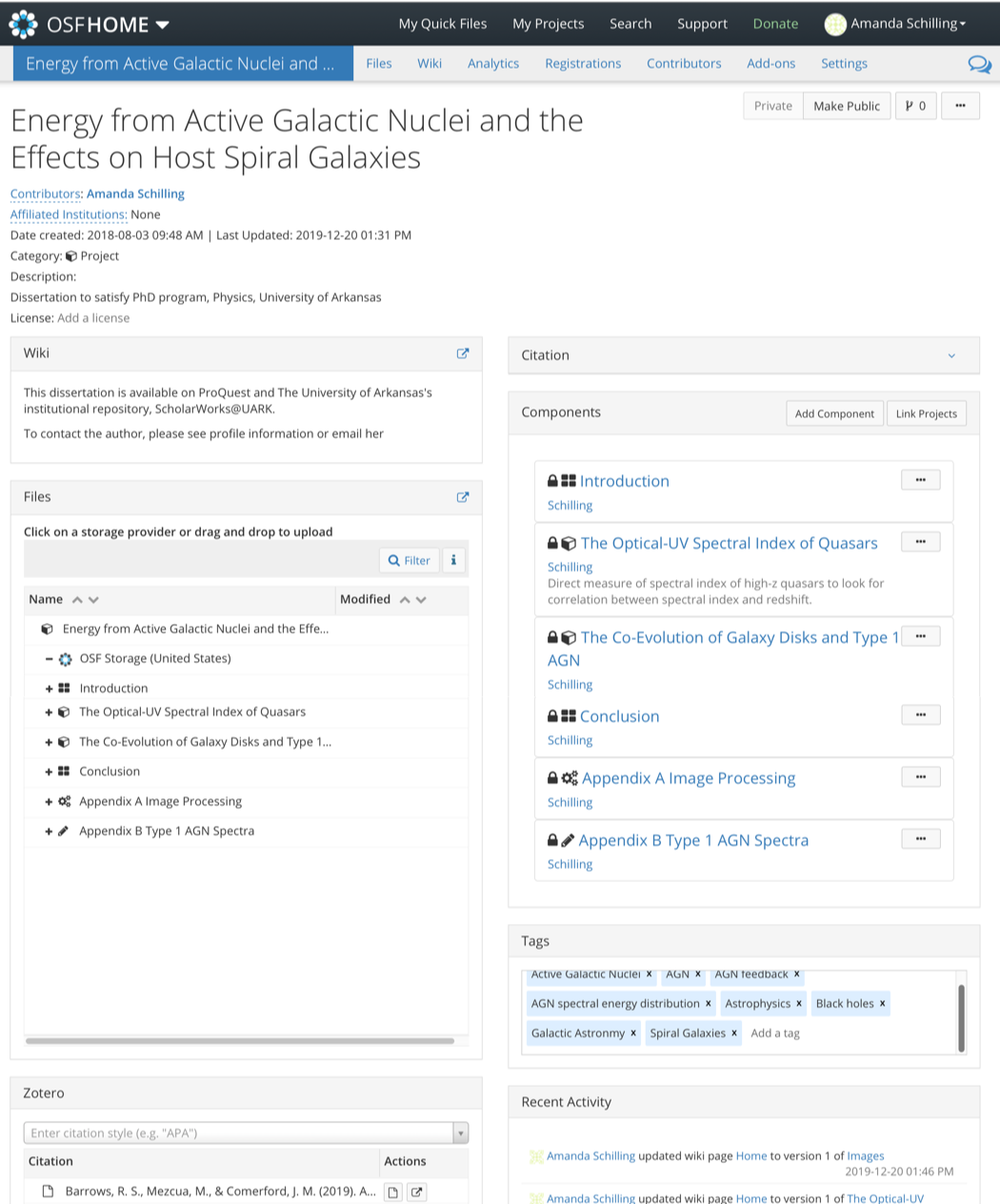
When you set up a project in OSF you can add collaborators to your project, and you can share your project with others. But because Amanda is using OSF to organize her dissertation materials, she has kept her project private and is the only contributor (contributor names, when they’ve been added, are listed under the title of the OSF project).
The main components of an OSF project include:
- a Wiki (top box on the left) where Amanda can add notes about the project, perhaps a to-do list, or even an abstract.
- Files that Amanda adds to this project are stored on OSF’s cloud service and are listed in the “Files” box under the wiki. There is no limit to the number of files that Amanda can add to OSF storage but each file must be, individually, 5 GB or less in size. She can also upload any file type to OSF, although not all types are rendered – this tool is not a place for editing files; instead, it is a pane in which to view files and track versions. You will want to do your editing elsewhere. When you upload your files they will appear here. Amanda can load a preview of some image files, Word and Powerpoint documents, and spreadsheets, which can even be sorted and searched in OSF. Seeing the contents of files is especially helpful when you’re looking at someone else’s project and considering downloading.
- Amanda can also connect files from other cloud services like DropBox and Google Drive. You can see in the box below the “Files” box, that Amanda has connected a folder from her Zotero account to her OSF project. If you use another service to store your files, you can link them to OSF by going to the “Add-ons” tab in the grey toolbar at the top of the page. There you’ll find a list of all the services compatible with OSF and the options for connecting each.
- To the right of the Zotero box you can see the tags Amanda added to her project, which will be useful if/when she decides to make this project public. People searching OSF for information and project about “spiral galaxies,” for example, will see Amanda’s project (assuming she has made it public) in their search results.
- Below the tags is the “Recent Changes” box, which is a list of recent changes made to the project.
- Next up is the “Components” box on the right. Amanda has organized her project by creating a component for each chapter in her dissertation. Clicking on the component “The Optical-UV Spectral Index of Quasars” bring us to this page:
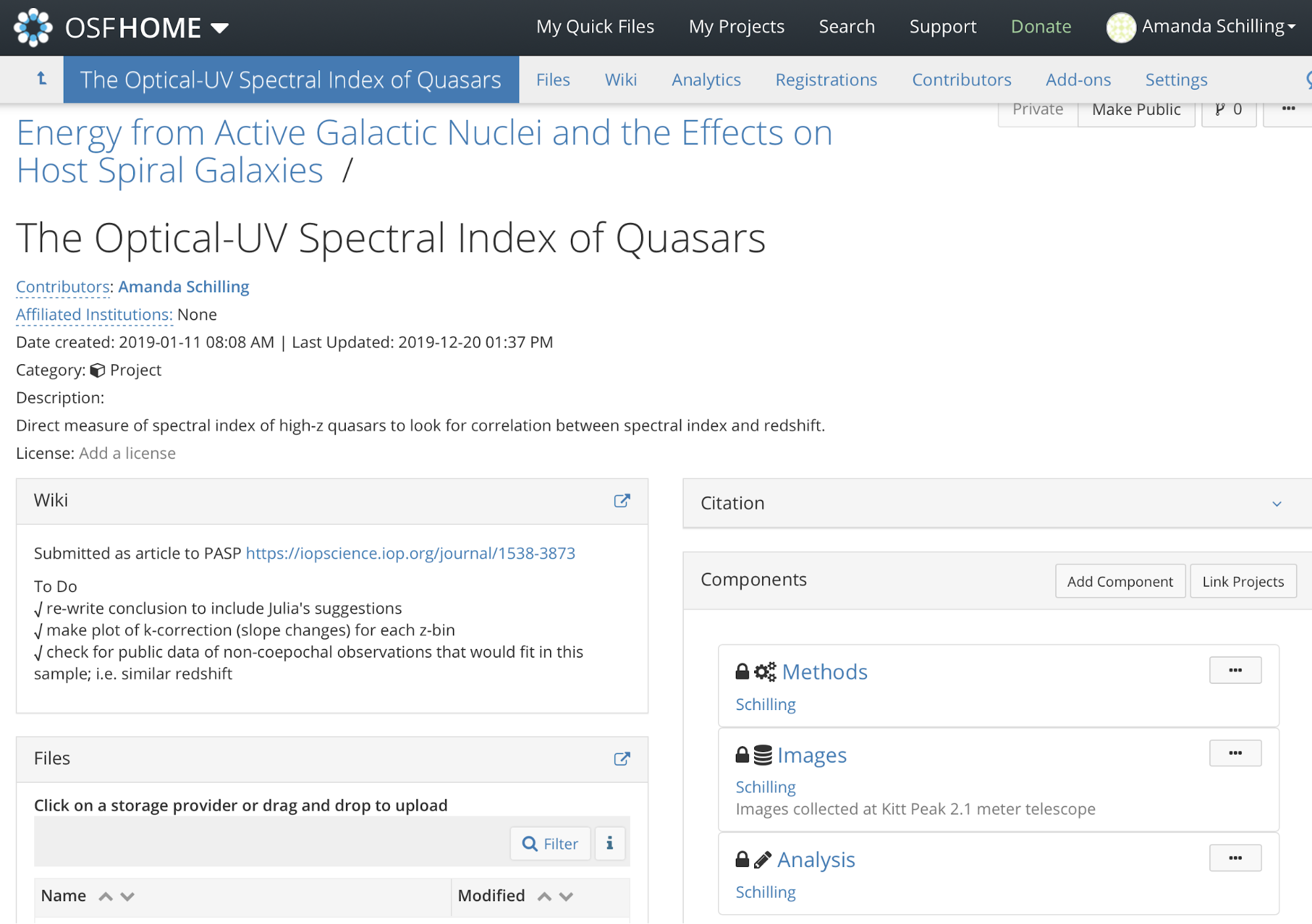
Look familiar? Each component in an OSF project has the same organization and layout as the project’s top-level page. And most of the settings are granular, which means Amanda can make a component private even if the project itself is public or, conversely, she can make just a single component public. Amanda can associate different files to a component than the ones that are associated with the top-level project; she can also create separate tags, descriptions, licenses etc. for components.
You can see that Amanda’s wiki is different for this component than the wiki on her top-level/main page. You can also see there are three components inside this component – “Methods,” “Images,” and “Analysis.” Let’s dive down one layer deeper to the “Images” component, which Amanda is using as the data for this chapter of her dissertation: 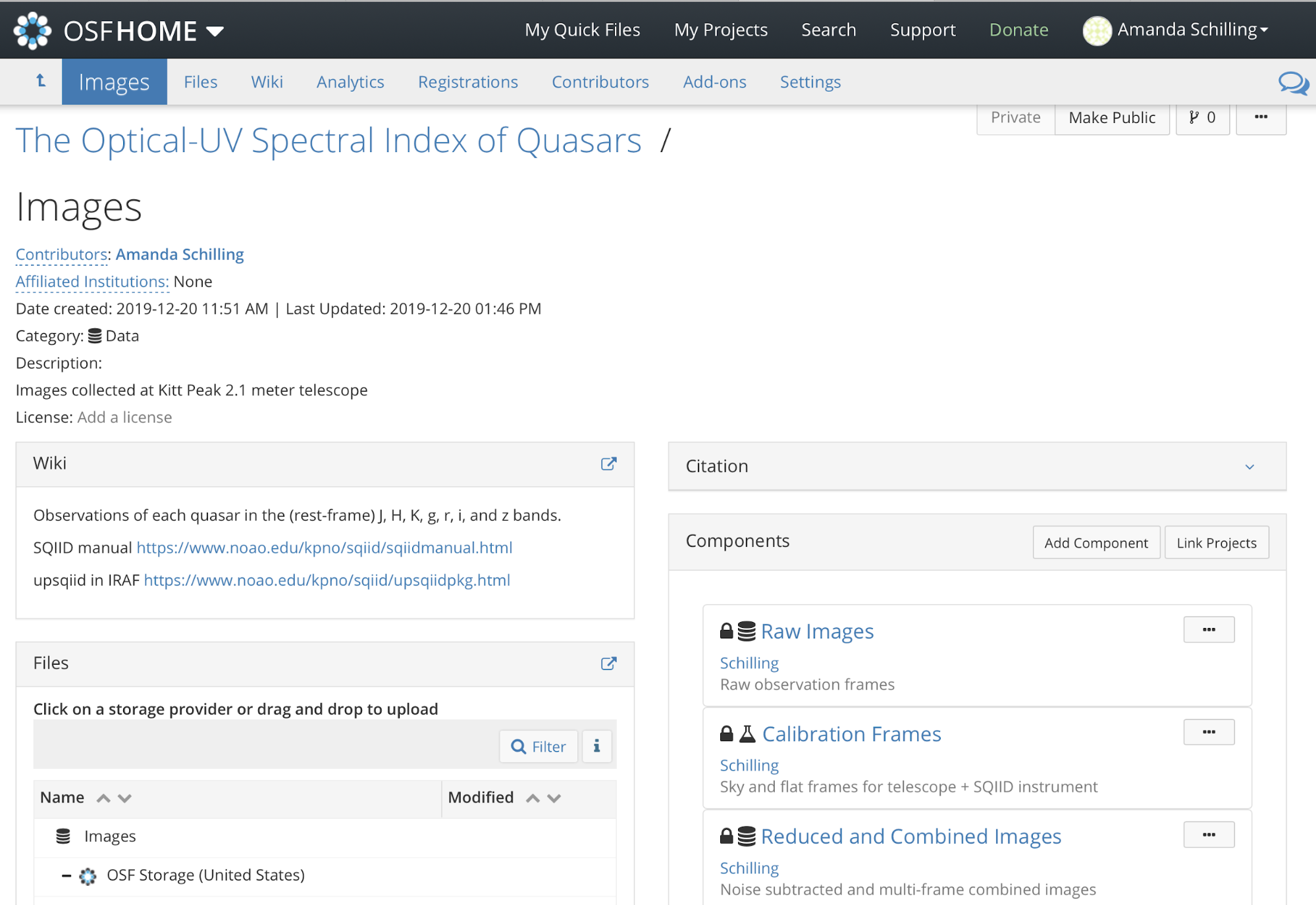
Once again, Amanda has written a separate wiki that describes her data and also has several components in the “Images” component including Raw Images, Calibration Frames, and Reduced and Combined Images (processed data). You can imagine this will be useful when Amanda wants to share her processed data – all she has to do is make “Reduced and Combined Images” a public component instead of keeping it private. And she doesn’t have to make any other component public!
Meet a group of librarians at OU
In our next example, you’ll be meeting a group of librarians who use OSF as a collaborative project manager and organize materials for the workshops they offer at OU. Take a look at their OSF project page: 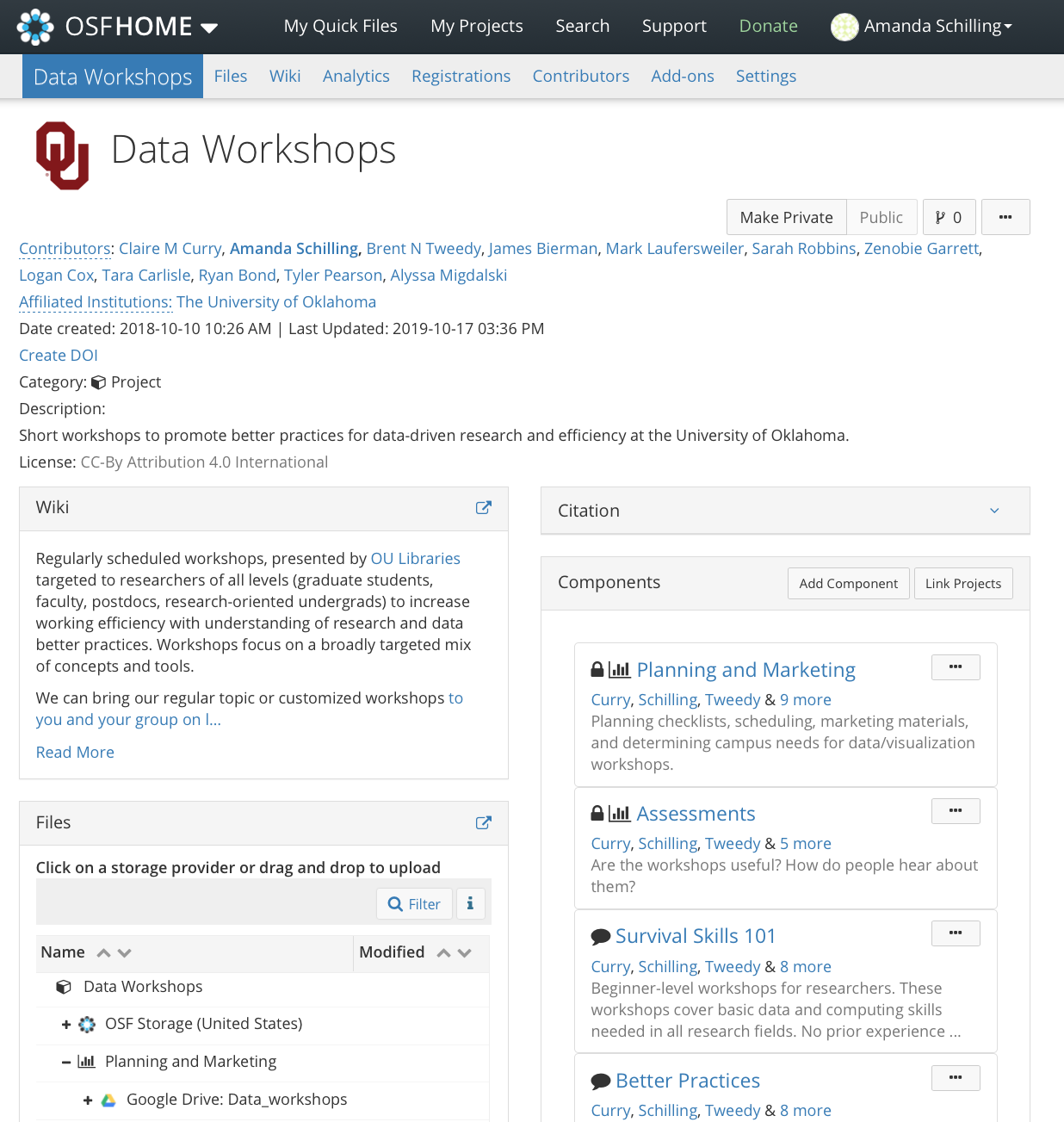
In this example, the name of the overarching project is “Data Workshops.” Next, you’ll see that this project has several contributors. What you aren’t able to see on this screen is that there is also an option to add “non-bibliographic” contributors who have access to the project but aren’t listed.
Next, you can see the affiliated institution, The University of Oklahoma, listed below the contributors.
The librarians working on this project have made it public, and a public project can also be assigned a DOI if you’d like. DOIs provide a permanent, stable link for your work, even if the URL changes. Further, many publishers and funding bodies require DOIs for data sets that accompany your article. Regardless, when you use OSF every project – public or private – has a short and persistent URL for the project, each component, and each file associated with the project. So assigning a DOI is optional and only if you need one.
Finally, you can see that these librarians and have given their project a Creative Commons license (listed under the description) so that others can more easily use, re-use, and build upon the project.
And in case you’re wondering, the “Data Workshops” projects is alive and real! You find it, explore it, or follow along at https://osf.io/ymzu8/.
Take a look at the “Components” box. Notice the lock icon next to the first two components, “Planning and Marketing” and “Assessments?” This lock indicates that those components are private and not publicly viewable. The other components, “Survival Skills 101” and “Better Practices” are public so that this team of librarians can share their materials with others who want to offer similar workshops. 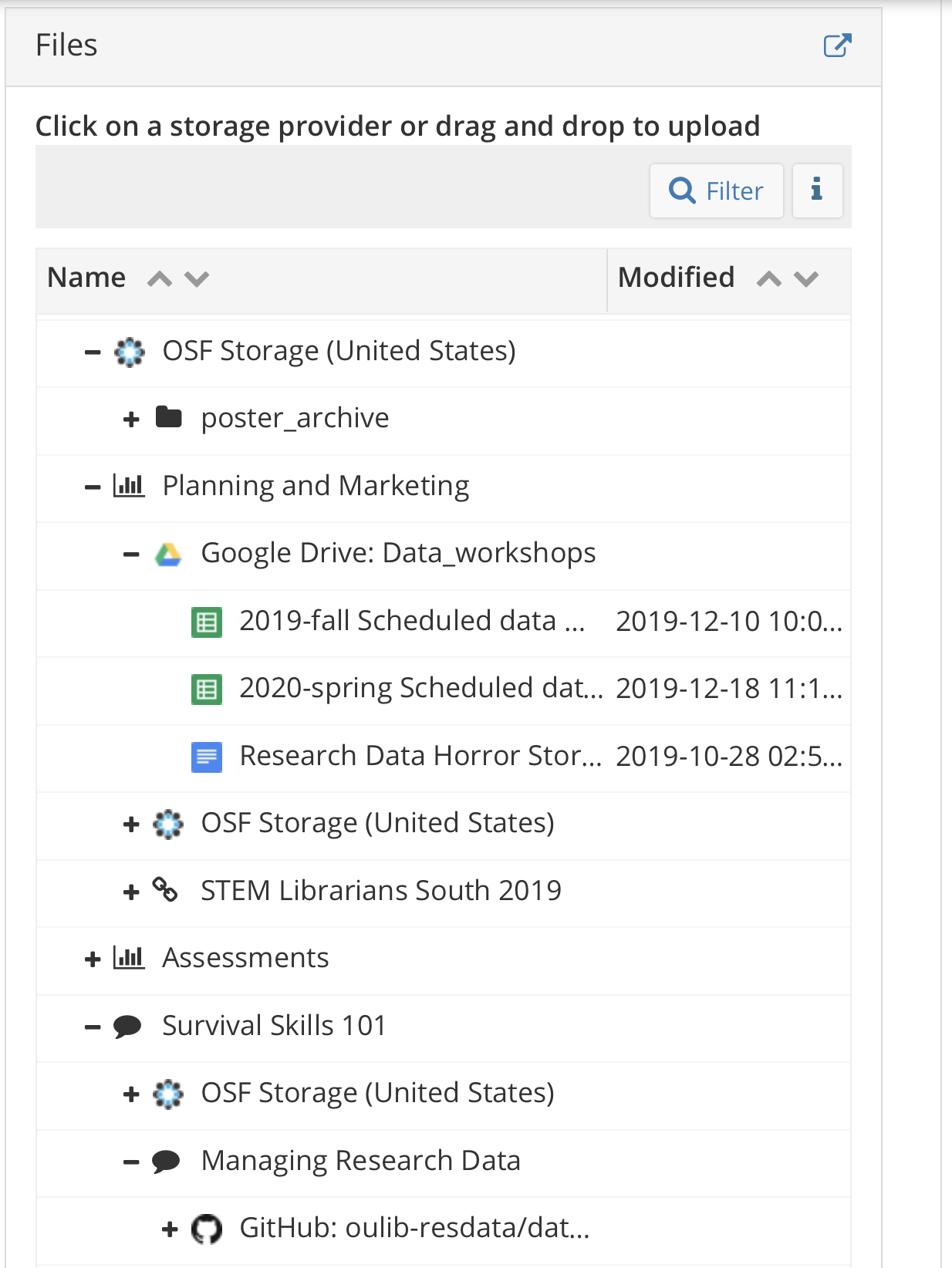
If we look more closely at the “Files” box, we see that this group is using OSF storage as well as Google Drive and even a GitHub repository. This is particularly helpful when working with a group of contributors who use different cloud services or platforms to save their work.
Other examples
We’ve introduced you to two use cases, but there are so many other projects that can benefit by using OSF:
- Instructors can arrange class materials to share with students, like the instructor of this hydrology class
- A research group can organize their projects including lab protocols, data management plans, and other documentation, like this group at Johns Hopkins University.
- A group of researchers from several different institutions collaborated to create a primer for collecting sensitive data in academic research. Even though the OSF-affiliated institution is MIT, members of this group also came from San Diego State University, University of Illinois, and James Madison University.
These are just three examples. Take some time to explore other public OSF projects by searching here or from the search box on the OSF home page.
It’s your turn!
Now that you’ve seen the basics of OSF, you’re going to get started on a project of your own. We promise – getting started is easy! Navigate to the OSF home page, and click on the “Sign Up” link at the top right or the “Get Started” button right in front of you.
The University of Oklahoma is an institutional member of OSF which means you can sign in using your OU credentials (4x4 and password) and start a project right away. In the sign-up box (see below), simply click on the “Institution” button. Select OU from the drop down menu (NOTE: it is listed as The University of Oklahoma, alphabetically by “T”) and enter your credentials.
If you are not affiliated with OU, you can sign up for an account with any email address or by using your ORCiD. 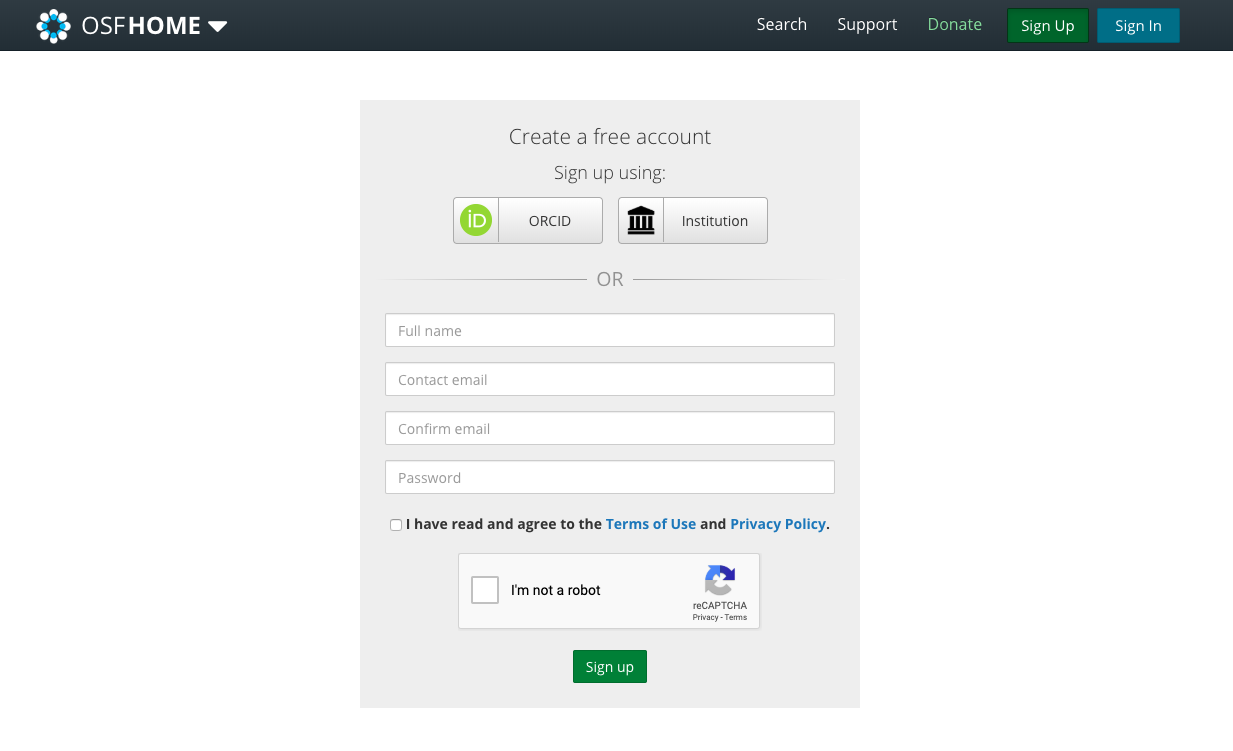
Once you’re logged in, click on the green button “Create new project” at the upper left, and go to town! You’ll be prompted for:
- Your project title
- Your project description
That’s it!
By default, your project will be private, so feel free to make notes, add files, and add components to your heart’s content. If you want to add collaborators, simply click on the “Contributors” link next to your name. A new window will open where you can add contributors (click on the green “+Add” button) and manage their permissions. If they do not already have an OSF account, you will be prompted for their email address. This is also the window where you can provide “view only” access to those with whom you want to share information but not provide them with administrative or editing permissions.
Homework
We know the power of OSF, so your homework for this unit to get accustomed to it by setting up (and managing) one of your projects in OSF. We also know that for some of you it can be tough to carve out the time to work on OU Impact Challenge activities on your own. If this describes you, we still have you covered! OU Libraries offers OSF workshops during the semester or by request. Check out the OU Libraries Events page or the calendar, and register for an upcoming OSF workshop when one is scheduled. And, of course, you can request additional help by contacting your liaison librarian, an information specialist, or by visiting the Data Services open office hours.
Finally, OSF maintains a robust set of support documents, including a number of guides on topics we didn’t include here.